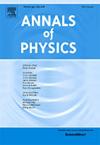A new representation of vacuum Lovelock solutions in d=2N+1 dimensions: Black holes with an integrable singularity and regular black holes
IF 3
3区 物理与天体物理
Q2 PHYSICS, MULTIDISCIPLINARY
引用次数: 0
Abstract
In recent years, black hole (BH) solutions with an integrable singularity have garnered significant attention as alternatives to regular black holes (RBH). In these models, similarly to RBHs, an object would not undergo spaghettification when approaching the radial origin. Instead of the potentially unstable de Sitter core present in RBHs, an integrable singularity emerges where the Ricci scalar diverges while its volume integral remains finite. However, the construction of both RBH solutions and BHs with an integrable singularity typically requires the inclusion of specific forms of matter in the energy–momentum tensor. We demonstrate that, from a geometric perspective in the absence of matter, vacuum solutions in Lovelock gravity in dimensions can be represented as vacuum BHs with an integrable singularity in Einstein–Gauss–Bonnet theory for and in cubic gravity for . Meanwhile, the vacuum solution in quartic gravity in is described as a vacuum RBH with a nontrivial hyperboloidal cross-section. For all the aforementioned cases, we have determined the conditions that the parameters in the solutions must satisfy. Remarkably, in all discussed cases, there is no presence of an internal horizon near a potentially unstable de Sitter core.
d=2N+1维真空Lovelock解的新表示:具有可积奇点的黑洞和规则黑洞
近年来,作为普通黑洞(RBH)的替代方案,具有可积分奇点的黑洞(BH)方案备受关注。在这些模型中,与普通黑洞类似,天体在接近径向原点时不会发生稀疏化。在这些模型中,里奇标量发散,而其体积积分保持有限,出现了一个可积分奇点,而不是 RBH 中潜在的不稳定的德西特核心。然而,要构建 RBH 解决方案和具有可积分奇点的 BH,通常需要在能动张量中包含特定形式的物质。我们证明,在没有物质的情况下,从几何学的角度来看,d=2N+1维的洛夫洛克引力中的真空解在爱因斯坦-高斯-波奈理论中可以表示为d=5的具有可积分奇点的真空BH,在立方引力中可以表示为d=7的具有可积分奇点的真空BH。同时,在 d=9 的四元引力中,真空解被描述为具有非对称双曲截面的真空 RBH。对于上述所有情况,我们都确定了解中参数必须满足的条件。值得注意的是,在所有讨论的情况中,潜在不稳定的德西特核心附近都不存在内部地平线。
本文章由计算机程序翻译,如有差异,请以英文原文为准。
求助全文
约1分钟内获得全文
求助全文
来源期刊

Annals of Physics
物理-物理:综合
CiteScore
5.30
自引率
3.30%
发文量
211
审稿时长
47 days
期刊介绍:
Annals of Physics presents original work in all areas of basic theoretic physics research. Ideas are developed and fully explored, and thorough treatment is given to first principles and ultimate applications. Annals of Physics emphasizes clarity and intelligibility in the articles it publishes, thus making them as accessible as possible. Readers familiar with recent developments in the field are provided with sufficient detail and background to follow the arguments and understand their significance.
The Editors of the journal cover all fields of theoretical physics. Articles published in the journal are typically longer than 20 pages.
 求助内容:
求助内容: 应助结果提醒方式:
应助结果提醒方式:


